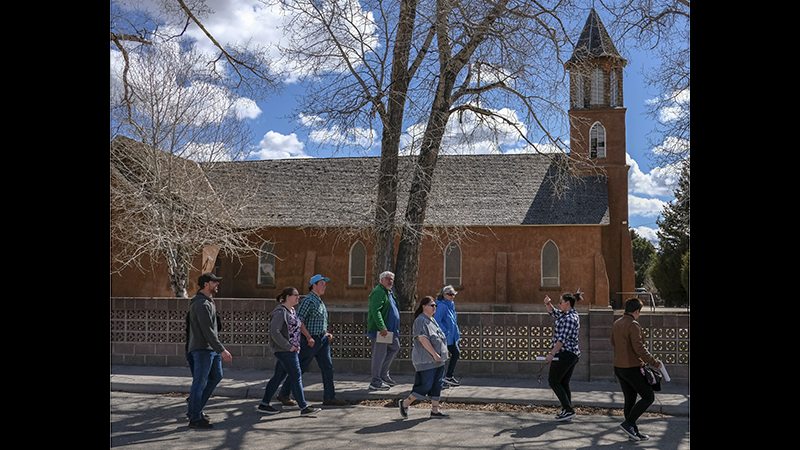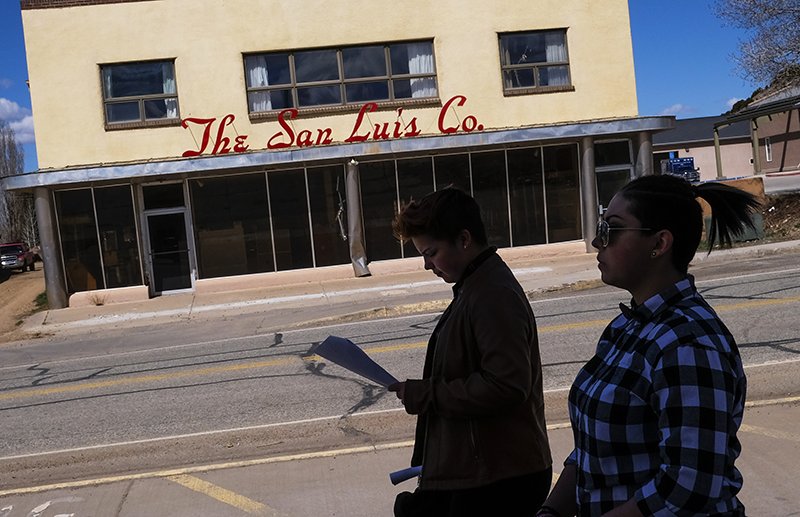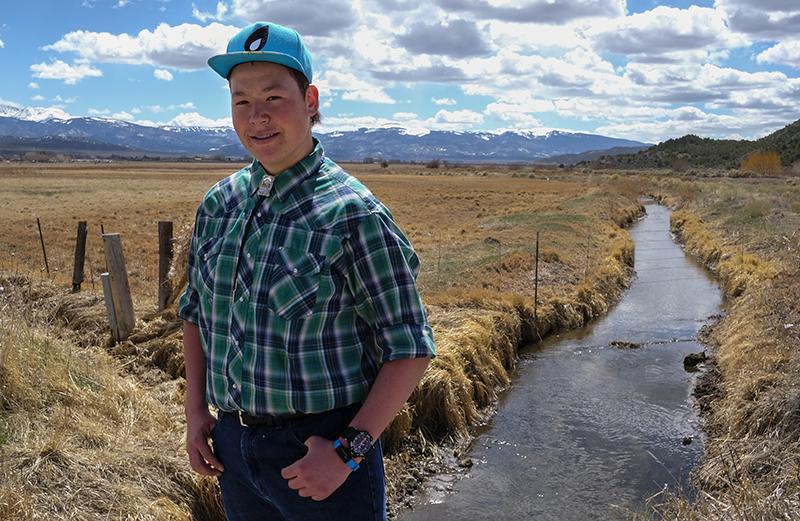San Luis Listens to the Kids
Leer en español
Rosa Mondragon, walking backward, leads a historical tour of San Luis. Photos by Joe Mahoney / Special to The Colorado Trust
By Kristin Jones
Rosa Mondragon, 15, can easily name her biggest fear.
“Big crowds scare the crap out of me,” she says. When she’s in a group, “I withdraw.”
You wouldn’t have known it, though, to watch her and Isabella Durgan, also 15, take turns leading a group on a historical tour of their southern Colorado town, San Luis, on a sun-soaked day in April.
They showed off the adobe church with the Gothic windows, the oldest continuously operated store in the state, and the communally owned irrigation system, called the acequias, that feeds water to the area.
“I think it went well,” Rosa said later. She learned from the experience, too: stop at each landmark instead of trying to walk backward; speak up; know your facts.
The tour was part of the town’s first annual Founders Day. San Luis was established in 1851, and many of its first settlers from Spain and Mexico have descendants still living here. The old-timers converse in Spanish and the younger ones in English or Spanglish; the town’s Manito culture has long adopted a mix of Spanish, Anglo and Indigenous influences, sometimes via nearby New Mexico.
The air smelled of wood smoke. Some people had found their way to the parish hall for a pancake breakfast and live music, while others headed into a 900-acre common area known as The Vega for a 5k run. By day’s end, about 300 people showed up for Founders Day events—roughly half the population of San Luis.
Rosa and Isabella are some of the newest members of a youth advisory council to Adelante San Luis, a group of residents who are working to change the trajectory of the town. (The Colorado Trust supports their efforts via its Community Partnerships strategy.) Like other rural towns in Colorado, San Luis has declined in population, and that’s a concern shared by both the younger and older residents of the town.
“If we don’t change now,” says Isabella, “San Luis is going to be in the history books.”
Adelante San Luis has identified its main goals as recapturing a greater sense of social connection, revitalizing the town’s culture and promoting economic development. Young people like Rosa and Isabella are key to the success of all these efforts, and they have their own ideas about what they’d like to see here.
Many of the young people say they want more opportunities for everyone—adults and kids. And they are impatient for the kind of change that comes from people working together.
“I’m going to grow up and leave,” says Isabella, “which is sad to say, but I’m not going to change the town by myself.”
“I’ll always come back,” says Rosa. “This is my home. I do want more opportunity, and if I can help build more opportunity in the however many years that I’m here, then that’s perfect. But I know I’ll always come back.”
 In a lot of places—especially places in economic distress—teenagers are seen as problems to be solved. Anti-drug, anti-gang or anti-pregnancy education is foisted on them with varying degrees of engagement and success.
In a lot of places—especially places in economic distress—teenagers are seen as problems to be solved. Anti-drug, anti-gang or anti-pregnancy education is foisted on them with varying degrees of engagement and success.
Here, they’re trying something different. The kids are invited into the work. Rosa and Isabella both say they didn’t feel listened to before joining Adelante San Luis, and didn’t feel connected to other people in the town. That’s changing, they say.
Several of the older team members, like Mario Peñuelas, 17, say they do feel respected in the community. Mario has been part of Adelante San Luis since its inception about four years ago.
“I liked thinking about, ‘How can I make San Luis better? How can I change it?’” says Mario. He was especially interested in learning about the culture of the area, and its fragility.
“The culture is being lost generation to generation,” he says. “To learn about the culture loss was a big shock to me. I love San Luis. People tend to focus on the bad things. But I’m proud of it: Our oral history, the events we have here, the Manito culture.”
Mario is finishing up his senior year of high school. He was accepted at Metropolitan State University in Denver, Adams State University in Alamosa, and Trinidad State Junior College. He’s thinking about the two-year college in Trinidad because of its program in diesel technology—another passion of his.
He sees himself starting a diesel mechanic shop in San Luis, and then, when he’s 40 or so, being in a position where he could step back from it and focus on giving back to the community.
Through Adelante San Luis, Mario has become active in other parts of the town leadership. He’s on the board of the Acequia Association, which manages the series of ditches that are important culturally and economically to the town and its surrounding lands.
 He feels listened to both on that board and in the meetings of Adelante San Luis—and he doesn’t take that for granted.
He feels listened to both on that board and in the meetings of Adelante San Luis—and he doesn’t take that for granted.
“I’m proud that this group invests in us—in young people,” says Mario. “That’s what I think is most powerful about it.”
The national conversation about young people these days tends to paint them as entitled, sheltered, addicted to video games, unable to connect. But the reality for many kids—especially those without a lot of family money—is that they have plenty of full-grown worries.
A few weeks before Founders Day, San Luis was showing its age. A springtime snow blew against its cracked storefronts and boarded-up windows, and few people were outside.
One and two at a time, though, teenagers opened the doors of Adelante San Luis’ office on Main Street, and sank into the bean bag chairs and yellow sofas inside, trading stories about some very hot peppers that somebody had brought to school, and gently teasing each other.
The Adelante San Luis space is a place for them to do homework, work on their own projects—Isabella is working on a children’s book—and get together with other teenagers.
That night, the youth advisory council was meeting. Cody Groff, a college student hired recently by a committee that included Isabella, was leading a training on public speaking. The kids had specifically requested it. Each of them had to give a 90-second speech on a randomly assigned topic, with little time to prepare.
Rosa talked about her fear of crowds, and how she had joined Adelante San Luis in part to change that. Isabella was asked to talk about a loss, which made her think about a friend of her younger childhood that she’d lost contact with. Mario was asked about what he’d dream about, if he could choose his dreams. He said he mostly dreams about the future, but also sometimes about a monster that sucks people into itself.
Adelia Romero, 16, was asked about what she fears.
“My biggest fear is losing my grandma,” she said. “She raised me since I was a baby. I have a mother and father, but they’re out of the question. My grandma holds my whole family together. When I’m sick, I go to her for comfort.
“I want to be successful to make her proud. That’s my other fear: That I won’t be successful and I’ll let her down.”
After she sat down, Cody asked the others to pay attention to what Adelia had just done. It can be tempting to use humor for an exercise like this, he told them, but speaking sincerely can be even more powerful.
Listening sincerely can be powerful, too.

